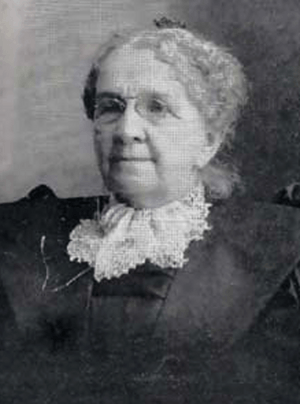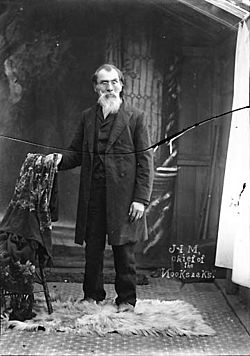Phoebe Judson facts for kids
Quick facts for kids
Phoebe Goodell Judson
|
|
|---|---|
 |
|
| Born |
Phoebe Newton Goodell
October 25, 1831 Ancaster, Ontario
|
| Died | January 16, 1926 (aged 94) |
| Nationality | |
| Known for | Named and established Lynden, Washington |
| Political party | Republican Party |
| Spouse(s) | Holden Allen Judson |
| Children | Anna Judson Charles La Bonta Judson George Holden Judson Mary Judson Carrie Judson (died in infancy) Skoqualamooch "Jack" Judson (adopted) foster children: John Marshall McClanahan Horace Greeley McClanahan Nora McClanahan Daniel Abbott Jr. McClanahan |
| Relatives | Isaac N. Ebey (son-in-law's father) |
Phoebe Goodell Judson (born October 25, 1831, died January 16, 1926) was a brave pioneer and writer from Canada and the United States. With her husband, Holden Judson, she helped start the city of Lynden, Washington. In 1886, she also started a school called the Northwest Normal School, which later became Western Washington University.
Phoebe kept a diary of her adventures starting from March 1, 1853, when her family left for the Washington Territory. She later turned this diary into a book called A Pioneer's Search for an Ideal Home: A Personal Memoir, which was published just before she passed away.
Because she played such a big part in building up the Nooksack Valley from the 1870s to the 1890s (and even named Lynden!), people often call her the "Mother of Lynden."
Contents
Phoebe's Early Life
Growing Up in Canada and Ohio
Phoebe Newton Goodell was born on October 25, 1831, in Ancaster, Canada. She was one of eleven children and had a twin sister named Mary. Her parents were Jotham Weeks Goodell, a Presbyterian minister, and Anna Glenning Bacheler. In 1837, when Phoebe was young, her family moved to Vermilion, Ohio, where she grew up.
On June 20, 1849, at age 17, Phoebe married Holden Allen Judson. They had grown up together in Vermilion. Their first child, Anna, was born the next year.
Moving West to Washington
In 1851, Phoebe's parents and some siblings moved to the Oregon Territory. They left Phoebe and her older brother William behind. Inspired by her family and her husband Holden's wish to be independent, Phoebe decided to move west.
On March 1, 1853, Phoebe, Holden, and their daughter Annie set off for the new Washington Territory. Just a few days before, her brother William had gotten married. He and his wife would follow the same path west the next year.
The Journey West: Overland Trail
Traveling by Steamboat and Wagon
The Judsons first took a train to Cincinnati, Ohio. Then they traveled by steamboat to St. Louis, Missouri, and then to Kansas Landing (now Kansas City, Missouri). From there, they went to West Port, Missouri, where they stayed in a hotel for five weeks. During this time, they got ready for their journey and built their wagon.
They joined a wagon train led by Rev. Gustavus Hines. Their group had six covered wagons and a carriage. Phoebe and Holden traveled with four oxen and a cow.
Life on the Trail
The wagon train left West Point on May 1, 1853. The Judsons learned that resting on Sundays, as Rev. Hines insisted, actually helped their oxen stay strong. They found that their group moved faster than others who didn't rest.
On June 26, 1853, Phoebe gave birth to her second child, Charles La Bonta Judson. He was named after La Bonta Creek in Wyoming, where he was born.
When the wagon train reached the Columbia River, the Judsons left their group. They went to Willamette, Oregon, to visit Phoebe's twin sister, Mary. They left their cattle with Mary's family. Then, they hired American Indian people to take them by canoe to Grand Mound, Washington. There, they claimed land next to Phoebe's parents. On this journey, Phoebe started to learn Chinook Jargon, a trade language, which she eventually spoke very well.
Settling in Washington
Grand Mound and Claquato Homes
In Grand Mound, the Judsons became good friends with the local Chehalis Indians. They learned Chinook Jargon from a man named Dean Clark, while teaching him English.
In 1853, the Judsons adopted a 10-year-old Chehalis boy named Skoqualamooch, who asked to be called "Jack Judson." That same year, Isaac Stevens, the first governor of Washington, visited Grand Mound. He decided to set up a temporary capital in Olympia, which later became the official state capital.
After building a log cabin in Grand Mound, the Judsons found the land was not good for farming. So, in 1854, they moved about 12 miles south to Claquato, Washington, along the Chehalis River. The land there was fertile, but Phoebe still didn't feel it was her "ideal home." They even had to get two dogs to keep bears away from their crops and animals!
The Puget Sound War
In 1855, the Puget Sound Indian War began. Holden's parents moved in with the Judsons for safety. The Chehalis Indians in Claquato were not openly hostile, but they did visit settlers' homes to see what they owned. When a small group of Indians tried to take over the Judson's land, Phoebe stopped her husband from fighting them, believing it would only make things worse.
Eventually, everyone in Claquato had to go to the Claquato Stockade Fort for safety. Even though nights were spent in the fort, Phoebe, Holden, Jack, and Holden's father worked during the day to harvest their crops.
Many of Phoebe's friends and neighbors were attacked and killed during the war. After the war ended, Phoebe saw Chief Leschi, who was blamed for starting the war, being executed. She felt this was wrong, believing he had been tricked into the rebellion. In 1858, Holden was elected to the Washington State Legislature. The Judsons moved to Olympia temporarily while he was working there.
Life in Olympia and Whidbey Island
In Olympia, Holden became friends with John A. Tennant, who lived in Whatcom County. Inspired by him, Holden invested in land there and helped build a trail to Whatcom (which later became Bellingham).
In 1859, the Judsons sold their Claquato land. They rented a house in Olympia, which became the first incorporated town in Washington. Phoebe gave birth to George Judson in 1859 and Mary Judson in 1862. Mary was partly raised by Holden's sister, Lucretia, and her husband, George Corliss, who had no children.
Sadly, in 1864, Mexican bandits robbed and killed the Corlisses in California. Because of this tragedy, the Judsons decided not to move there. Instead, they moved to Whidbey Island in 1866. Phoebe had another child, Carrie, in 1869, but she died a month later.
Finding the Ideal Home: Lynden
Moving to the Nooksack Valley
In 1871, Holden met James Alexander Patterson, who owned land next to a Nooksack Indian camp called Squahalish in the Nooksack Valley. Patterson had married a young Lummi princess named Lizzie, but he treated her poorly. Lizzie eventually left him, leaving her two young daughters, Dollie and Nellie, behind. Patterson couldn't care for the children or the farm alone. He convinced the Judsons to foster his daughters and gave Phoebe his land and cattle.
On March 1, 1871, Phoebe and Holden, along with Dollie, Nellie, and their sons Bonta and George, moved to the Nooksack Valley. Their daughter Mary stayed on Whidbey Island for school. When Phoebe went back to get Mary, her son-in-law, Eason Ebey, read her a poem called Hohenlinden. This poem later inspired Phoebe to name their new settlement "Lynden".
There were no roads to Whatcom, so the Judsons took a steamboat to Bellingham Bay. From there, a Nooksack Indian couple, Sally and Joe, canoed them up the Nooksack River. The journey took two days because of large log jams in the river. The Patterson property had a small log cabin and a barn on a plateau with a view of Mount Baker. Phoebe later said she felt a "sense of satisfaction" at this spot, more than any other home. The Judsons built a larger, two-story house, using the old cabin as their kitchen.
Life with Neighbors and New Ideas
The local Nooksack Indians were influenced by a Catholic mission on the Lummi territory. Sally and Joe, the Judsons' neighbors, practiced a mix of Catholicism and worship of the "Sothalic Tyee" (Great Spirit).
After the Nooksack's medicine man died, Sally's daughter Holatchie became sick. Sally sent for a priest from the Lummi mission. After the priest left, Phoebe, who often acted as a physician in the area, felt inspired to share her Protestant beliefs with her neighbors. She explained ideas like universal priesthood and divine grace, which Sally liked.
The Judsons also took in three more children, John, Horace, and Norah, after their neighbor Daniel McClanahan died. Later, Daniel's youngest child, also named Daniel, joined them after his mother passed away. For two years, Phoebe was the only white woman in the area.
Naming and Building Lynden

In 1874, the Judsons turned their home into a post office, with Holden as postmaster. Phoebe was given the job of naming their settlement. Holden suggested "Judson," but Phoebe chose "Lynden" from the poem she had heard. She changed the spelling from "Linden" to "Lynden" because she liked how it looked. Phoebe dreamed of her children having a wonderful life and a good education. She also wanted the world to have peace.
That same year, Phoebe's youngest brother Henry and their mother Annie came to live with them. Holden was also elected to the county commission. A flood destroyed their livestock, but their son-in-law replaced them with sheep. The next year, Phoebe became very ill with typhoid fever but recovered. She then started making wool socks for the single men in Lynden, whom she often invited for Christmas.
A Methodist missionary named Charles M. Tate came to Lynden in the late 1870s to teach the Nooksacks about Christianity. He used Judson's house as a mission. Chief Seclamatan, Sally, and even the homesteader John Tennant, became Christians. Later, Tennant moved to Lynden and became the first resident minister. His wife, Clara, became good friends with Phoebe.
The Judsons were very important in building the early infrastructure of Lynden and Whatcom County. Phoebe asked Holden to get the Nooksack Indians to help remove the "Little Jam" log jam, which they happily did. After that, Phoebe and Holden raised money to hire someone to remove the "Big Jam" in 1877. Phoebe cooked meals for the Indian workers. They also created the first trail to what is now Fishtrap Creek, where there was a communal fishtrap.
After Washington became a state in 1889, the population of Whatcom County grew quickly. The Judsons sold most of their land, keeping only two acres to build a new house. They guided new settlers to build the city of Lynden on the flat plateau. The Judsons set aside land for two important buildings: Phoebe organized the building of the Northwest Normal School (which later became Western Washington University), and Holden built the Judson Opera House. On March 16, 1891, Lynden officially became a city, and Holden Judson was elected its first mayor.
Phoebe's Later Years and Legacy
Phoebe Judson lived longer than all but her two oldest children, Annie and Bonta. She also outlived all her siblings and raised their orphaned children until her own death. On October 26, 1899, her husband Holden died at age 71.
Phoebe Judson passed away on January 16, 1926, from natural causes. To honor her, the entire city of Lynden shut down on January 18. Stores closed and schools were dismissed for her funeral. Phoebe Judson is remembered as a true pioneer who helped shape the history of Washington State.
See also
- Lynden, Washington
- Yelkanum Seclamatum
- Nooksack Valley

